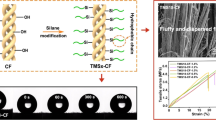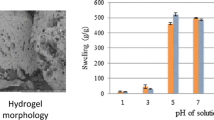Abstract
The goal of the paper is to present the preparation, characterization and testing of a new type of polyelectrolyte based on acrylamide and hydrolyzed collagen for flocculation purposes. Two kinds of hydrolyzed collagen with different molecular weights have been obtained from tanned leather by-products. Col I type having a molecular weight of 14,900 Da was prepared by chemical enzymatic processing and Col II type of 16,300 Da by chemical processing. Polyelectrolytes, also called flocculants, were obtained by electron beam irradiation with doses between 2 and 4.5 kGy in atmospheric conditions and at room temperature. The obtained flocculants were characterized using various physical and chemical methods to determine the conversion coefficient, residual monomer content, intrinsic viscosity, molecular weight and radius of gyration. Also, the flocculants were characterized by Fourier transform infrared spectroscopy technique to highlight the collagen binding to the acrylamide structure and by scanning electronic microscopy to investigate the microstructure. A possible reaction mechanism was proposed. The flocculation characteristics were evaluated in 0.2 wt% kaolin suspension at room temperature.



















Similar content being viewed by others
References
Brostow W, Lobland EHE, Pal S, Singh RP (2009) Polymeric flocculants for wastewater and industrial effluent treatment. J Mater Educ 31:157–166
Pandey SR, Tripathy T, Panda J, Wan K, Jain SK, Lan NT (2004) Biodegradable drag reducing agents and flocculants based on polysaccharides: materials and applications. Polym Eng Sci 40:46–60
Daughton CG (1988) Quantitation of acrylamide (and polyacrylamide): critical review of methods for trace determination/formulation analysis & future-research recommendations. Final Report No. CGD-02/88, The California Public Health Foundation, Berkeley, CA
Martin D, Ighigeanu DI, Mateescu EN, Craciun GD, Calinescu II, Iovu HM, Marin GG (2004) Combined microwave and accelerated electron beam irradiation facilities for applied physics and chemistry. IEEE Trans Ind Appl 40:41–52
Manaila E, Martin D, Craciun G, Ighigeanu D, Oproiu C, Iacob N (2005) Electron beam processed polyelectrolytes. In: Proceedings of international symposium on utilization of accelerators, Dubrovnik, Croatia, IAEA-CN-115-49, pp 1–8
Martin D, Fiti M, Radu A, Dragusin M, Cojocaru G, Margaritescu A, Indreas I (1995) Low power-high energy linacs for irradiation in polymeric systems. Radiat Phys Chem 45:615–621
Martin D, Dragusin M, Radu A, Oproiu C, Radoiu M, Cojocaru G, Marghitu S (1996) IAP linacs in applied research. Nucl Instrum Meth B 113:106–109
Martin D, Dragusin M, Radoiu M, Moraru R, Radu A, Oproiu C, Cojocaru G (1996) Polymers for waste water treatment. Prog Coll Pol Sci S 102:147–151
Martin D, Radoiu M, Dragusin M, Cramariuc R, Indreas I, Oproiu C, Marghitu S, Manea A, Toma M, Bestea V (1999) Electron beam technologies for preparation of polymeric materials used for wastewater treatment, agriculture and medicine. Mater Manuf Process 14:347–364
Giusti P, Lazzeri L, Petris S, Palla M, Cascone MG (1994) Collagen-based new bioartificial polymeric materials. Biomaterials 15:1229–1233
Cascone MG, Giusti P, Lazzeri L, Pollicino A, Recca A (1996) Surface characterisation of collagen-based bioartificial polymeric materials. J Biomat Sci Polym E 7:917–924
Sionkowska A (2003) Interaction of collagen and poly(vinyl pyrrolidone) in blends. Eur Polym J 39:2135–2140
Zuga MD, Iovu H, Trandafir V, Manaila E, Martin D, Stelescu MM (2007) Study on the preparation of some biocomposites based on silicone elastomers and collagen. J Optoelectron Adv Mater 9:3325–3329
Fu W, Liu Z, Feng B, Hu R, He X, Wang H, Yin M, Huang H, Zang H, Wang W (2014) Electrospun gelatin/PCL and collagen/PLCL scaffolds for vascular tissue engineering. Int J Nanomed 9:2335–2344
Sedliacik J, Matyasoysky J, Smidriakova M, Jurkovic P (2011) Application of collagen colloid from chrome shavings for innovative polycondensation adhesives. J Am Leather Chem Assoc 106:332–340
Piazza GJ, Garcia RA (2010) Proteins and peptides as renewable flocculants. Bioresour Technol 101:5759–5766
Piazza GJ, Garcia RA (2013) Proteolysis of meat and bone meal to increase utilization. Anim Prod Sci 54:200–206
Wang XC, Zhang S, Zhou L, Ren LF (2011) Preparation and characterization of a cationic flocculant based on modified collagen. J Func Mater 42(12):2221–2224
Martin D, Jianu A, Bestea V, Toma M, Oproiu C, Marghitu S (1999) Control system for ALID-7 linear accelerator used in radiation processing. Rev Sci Instrum 70:2984–2987
Craciun G, Martin D, Manaila E, Nemtanu M, Brasoveanu M, Ighigeanu D (2009) Biodegradable polyelectrolytes obtain by radiation polymerization. In: Proceeding of the 7th nuclear and particle physics conference, pp 615–626
Caulfield MJ, Hao X, Qiao GG, Solomon DH (2003) Degradation on polyacrylamides. Part I. Linear polyacrylamide. Polymer 44:1331–1337
Sarkar AK, Mandre NR, Panda AB, Pal S (2013) Amylopectin grafted with poly(acrylic acid): development and application of a high performance flocculant. Carbohydr Polym 95:753–759
Ghosh S, Sen G, Jha U, Pal S (2010) Novel biodegradable polymeric flocculant based on polyacrylamide-grafted tamarind kernel polysaccharide. Bioresour Technol 101:9638–9644
Zhang S, Wang W, Wang H, Qi W, Yue L, Ye Q (2014) Synthesis and characterization of starch grafted superabsorbent via 10 MeV electron beam irradiation. Carbohydr Polym 101:798–803
Caulfield MJ, Hao X, Qiao GG, Solomon DH (2003) Degradation on polyacrylamides. Part II. Polyacrylamide gels. Polymer 44:3817–3826
Selvapathy P, Reddy MJ (1992) Effects of polyelectrolytes on turbidity removal. Water Supply 10:175–178
Dimonie M, Boghina C, Cincu C, Marinescu M, Marinescu N (1986) Polyacrylamide. Technical Publishing House, Bucharest
Richardson RK, Kasapis S (1998) Rheological methods in the characterization of food biopolymers. Dev Food Sci 39:1–48
Rao MA (2007) Rheology of fluid and semisolid foods. Springer Science + Business Media, New York
Zeynali ME, Rabbii A (2002) Alkaline hydrolysis of polyacrylamide and study on poly(acrylamide-co-sodium acrylate) properties. Iran Polym J 11:269–275
Brostow W, Pal S, Singh RP (2007) A model of flocculation. Mater Lett 61:4381–4384
Pal S, Mal D, Singh RP (2007) Synthesis and characterization of cationic guar gum: a high performance flocculating agent. J Appl Polym Sci 105:3240–3245
Shogren RL (2009) Flocculation of kaolin by waxy maize starch phosphates. Carbohydr Polym 76:639–644
Patterson PM, Jamieson AM (1985) Molecular weight scaling of the transport properties of polyacrylamide in water. Macromolecules 18:266–272
Odian G (2004) Principles of polymerization. Wiley, New Jersey
Manaila E, Craciun G, Stelescu MD, Ighigeanu D, Ficai M (2014) Radiation vulcanization of natural rubber with polyfunctional monomers. Polym Bull 71:57–82
Kiatkamjornwong S, Chomsaksakul W, Sonsuk M (2000) Radiation modification of water absorption of cassava starch by acrylic acid/acrylamide. Radiat Phys Chem 59:413–427
Xie C, Feng Y, Cao W, Teng H, Li J, Lu Z (2009) Novel biodegradable flocculating agents prepared by grafting polyacrylamide to konjac. J Appl Polym Sci 111:2527–2536
Khouryieh HA, Herald TJ, Aramouni F, Alavi S (2007) Intrinsic viscosity and viscoelastic properties of xanthan/guar mixtures in dilute solutions: effect of salt concentration on the polymer interactions. Food Res Int 40:883–893
Flory PJ (1953) The structure of vinyl polymers. In: Cornell University Press (ed.) Principles of polymer chemistry, New York, pp 308–314
Rao MA (1999) Introduction in Rheology of fluid and semisolid foods. Aspen Publishers, Gaithersburg
Safranj A, Nagaoka N, Yoshida M, Kubota H, Omichi H, Katakai R (1995) Radiation polymerization and crosslinking of N’-isopropylacrylamide in aqueous solution and in solid state. Japan-China bilateral symposium on radiation chemistry; Tokyo (Japan); 6–11 Nov 1994, Report: JAERI-Conf 95-003, pp 434–438
Inamura PY, Shimazaki K, de M, Souza C, Colombo MA, Moura EAB, del Mastro NL (2009) Electron beam effects on gelatin polymer. INAC 2009 Rio de Janeiro, RJ, Brazil, September 27 to October 2, ASSOCIAÇÃO BRASILEIRA DE ENERGIA NUCLEAR—ABEN, ISBN: 978-85-99141-03-8
Craciun G, Manaila E, Stelescu MD (2016) Electron beam synthesis and characterization of acrylamide/acrylic acid hydrogels using trimethylolpropane trimethacrylate as cross-linker. J Chem. Article Number: 1470965, doi:10.1155/2016/1470965
Saraydın D, Saraydın SU, Karadag E, Guven O (2014) Radiation synthesized acrylamide hydrogel: preparation, characterization and usability as biomaterial. J Biol Chem 42(1):129–141
Magalhaes ASG, Neto MPA, Bezerra MN, Ricardo NMPS, Feitosa JPA (2012) Application of FTIR in the determination of acrylate content in poly(sodium acrylate-co-acrylamide) superabsorbent hydrogels. Quim Nova 35:1464–1467
Murugan R, Mohan S, Bigotto A (1998) FTIR and polarised Raman spectra of acrylamide and polyacrylamide. J Korean Phys Soc 32:505–512
Ficai A, Albu MG, Birsan M, Sonmez M, Ficai D, Trandafir V, Andronescu E (2013) Collagen hydrolysate based collagen/hydroxyapatite composite materials. J Mol Struct 1037:154–159
Kittiphattanabawon P, Benjakul S, Visessanguan W, Shahidi F (2010) Isolation and properties of acid- and pepsin-soluble collagen from the skin of blacktip shark (Carcharhinus limbatus). Eur Food Res Technol 230:475–483
Palpandi C, Ramasamy P, Rajinikanth T, Vairamani S, Shanmugam A (2010) Extraction of collagen from mangrove archeaogastropod Nerita (Dostia) crepidularia Lamarck. Am Euras J Sci Res 5:23–30
Payne KJ, Veis A (1988) Fourier transform ir spectroscopy of collagen and gelatin solutions: deconvolution of the amide I band for conformational studies. Biopolymers 27:1749–1760
Surewicz WK, Mantsh HH (1988) New insight into protein secondary structure from resolution enhanced infrared spectra. Biochim Biophys Acta 952:115–130
Doyle BB, Bendit EG, Blout ER (1975) Infrared spectroscopy of collagen and collagen-like polypeptides. Biopolymers 14(5):937–957
Smidriakova M, Laurova M (2011) ATR-FTIR spectral analysis of modified UF adhesive. Annals of Warsaw University of Life Sciences—SGGW. For Wood Technol 76:49–53
Wang J-P, Chen Y-Z, Zhang S-J, Yu H-Q (2008) A chitosan-based flocculant prepared with gamma-irradiation-induced grafting. Bioresour Technol 99:3397–3402
Wang J-P, Chen Y-Z, Yuan S-J, Sheng G-P, Yu H-Q (2009) Synthesis and characterization of a novel cationic chitosan-based flocculant with a high water-solubility for pulp mill wastewater treatment. Water Res 43:5267–5275
Manaila E, Craciun G, Stelescu MD, Ighigeanu D, Ficai M (2014) Radiation vulcanization of natural rubber with polyfunctional monomer. Polym Bull 71:57–82
Stelescu MD, Manaila E, Craciun G (2013) Vulcanization of ethylene-propyleneterpolymer-based rubber mixtures by radiation processing. J Appl Polym Sci 128:2325–2336
Stelescu MD, Manaila E, Zuga N (2011) The use of polyfunctional monomers in the radical cure of chlorinated polyethylene. Polym J 43:792–800
Stelescu MD, Manaila E, Craciun G, Zuga N (2012) Crosslinking and grafting ethylene vinyl acetate copolymer with accelerated electrons in the presence of polyfunctional monomers. Polym Bull 68:263–285
Fiti M (1967) Action of ionizing radiations on water and aqueous solutions. Publishing House of the Socialist Republic Romania, Bucharest
Bjergbakke E (1970) Procedures in radiation dosimetry. In: Holm NW, Berry RJ (eds) Manual of radiation dosimetry. Marcel Dekker Inc., New York, pp 319–321
Fiti M (1973) Chemical dosimetry of ionizing radiations. Publishing House of the Socialist Republic Romania, Bucharest
Sadeghi M, Hosseinzadeh H (2010) Synthesis and super-swelling behavior of a novel low salt-sensitive protein-based superabsorbent hydrogel: collagen-g-poly(AMPS). Turk J Chem 34:739–752
Bardajee GR, Pourjavadi A, Sheikh N, Amini-Fazl MS (2008) Grafting of acrylamide onto kappa-carrageenan via g-irradiation: optimization and swelling behavior. Radiat Phys Chem 77:131–137
Marandi GB, Mahdavinia GR, Ghafary S (2011) Collagen-g-poly(sodium acrylate-co-acrylamide)/sodium montmorillonite superabsorbent nanocomposites: synthesis and swelling behavior. J Polym Res 18:1487–1499
Iwaki M, Yakovlev G, Hirst J, Osyczka A, Dutton PL, Marshall D, Rich PR (2005) Direct observation of redox-linked histidine protonation changes in the iron-sulfur protein of the cytochrome bc1 complex by ATR-FTIR spectroscopy. Biochemistry 44(11):4230–4237
Rajarajan K, Anbarasan K, Samu Solomon J, Madhurambal G (2012) XRD and FT-IR studies on lead (II) nitrate doped histidine picrate crystal: a nonlinear optical material. J Chem Pharm Res 4(8):4060–4065
Padmaja L, Vijayakumar T, Joe IH, Nair CPR, Jayakumar VS (2006) Vibrational spectral studies and the non-linear optical properties of a novel NLO material l-prolinium tartrate. J Raman Spectrosc 37(12):1427–1441
Sheena Marya Y, Ushakumarib L, Harikumarc B, Tresa Varghesed H, Yohannan Panickerb C (2009) FT-IR, FT-Raman and SERS spectra of l-proline. J Iran Chem Soc 6(1):138–144
Barth A (2000) The infrared absorption of amino acid side chains. Prog Biophys Mol Biol 74:141–173
Castellano P, Vignolo G, Farías RN, Arrondo JL, Chehin R (2007) Molecular view by Fourier transform infrared spectroscopy of the relationship between lactocin 705 and membranes: speculations on antimicrobial mechanism. Appl Environ Microbiol 73(2):415–420
Acknowledgments
The authors are indebted to Dr. Catalin Luculescu for his support in sample investigation by the SEM technique.
Author information
Authors and Affiliations
Corresponding author
Rights and permissions
About this article
Cite this article
Craciun, G., Manaila, E., Niculescu, M. et al. Obtaining a new type of polyelectrolyte based on acrylamide and hydrolyzed collagen by electron beam irradiation. Polym. Bull. 74, 1299–1326 (2017). https://doi.org/10.1007/s00289-016-1778-0
Received:
Revised:
Accepted:
Published:
Issue Date:
DOI: https://doi.org/10.1007/s00289-016-1778-0




